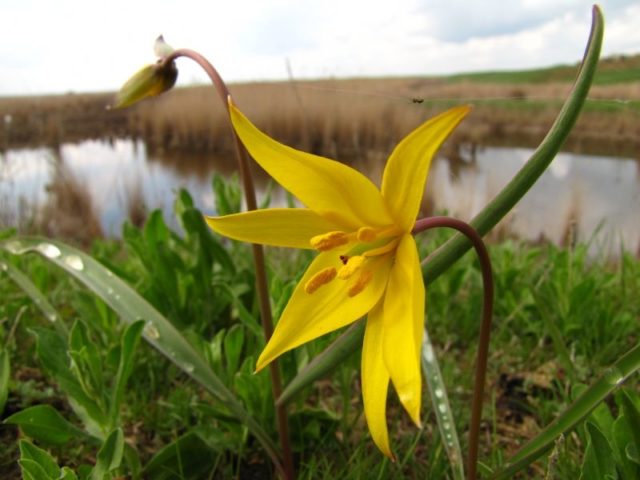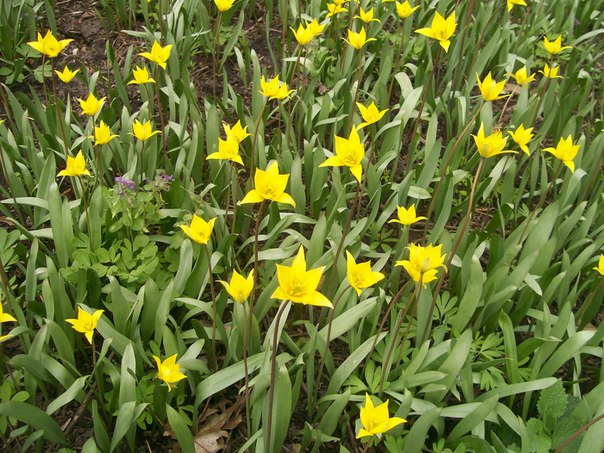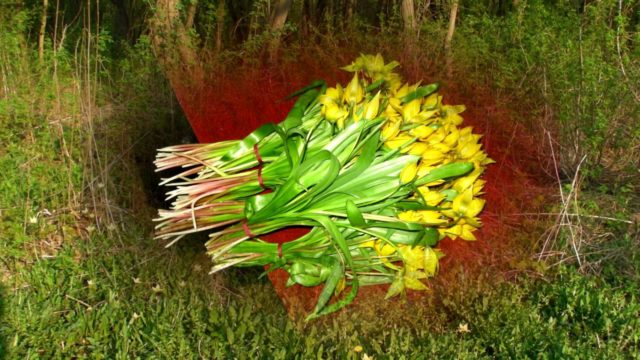Content
Tulips fascinate with their tenderness and beauty. These flowers belong to the genus of perennial herbaceous plants, numbering about 80 different species. One of the most interesting and original representatives is the Bieberstein tulip, or oak, growing in the wild. The variety was named in honor of the first collector, a Russian botanist who studied the flora of the Caucasus, FK Biberstein-Marshall.

Outwardly, the Bieberstein tulip resembles a snowdrop
Description tulip Bieberstein
The Bieberstein tulip (tulipa biebersteiniana) belongs to the bulbous plants of the Liliaceae family. The bulb is small, 1-2 cm in diameter, cone-shaped, with black-brown scales and pubescence at the top and base.
The stem of the flower is straight, naked, it grows to a height of 15-40 cm.The color of the leaves is rich green, their length is about 3 cm.
Flowers are solitary, drooping, painted in bright yellow color. Their shape resembles an asterisk, the diameter of which does not exceed 3-5 cm. The fruits are an erect, dry box with a sharp top, about 1.5-2.5 cm long.
The Bieberstein tulip blooms with the onset of warmth, in April-May, bears fruit in May-June. The plant is quite light-loving, therefore, flowering begins before the foliage of trees, the crowns of which can create excessive shade. The flowers exude a strong, pleasant scent.
Propagated by daughter bulbs and seeds, the plant spontaneously throws out ripe seeds around itself.

Seeds germinate with ease, forming whole flower glades
Where does the Bieberstein tulip grow?
Under natural conditions, the Bieberstein tulip grows in the steppes, on stony calcareous slopes, saline areas, shaded forest edges and in thickets of bushes. It is ubiquitous in the European part of Russia (Moscow, Rostov, Volgograd regions), in the North Caucasus (Krasnodar and Stavropol Territories), in Western Siberia, in the east and southeast of Europe, in southwestern and northern Asia, in Kazakhstan.
Is the Bieberstein tulip listed in the Red Book?
Biberstein's tulip grows in several specially protected natural areas (SPNA) in Russia. The flower is listed in the Red Book of the Moscow, Astrakhan, Lipetsk, Samara, Ulyanovsk, Volgograd, Penza and Rostov Regions, Krasnodar and Stavropol Territories. He also has a protective status in the republics of Bashkortostan, Tatarstan, Kalmykia, Mordovia, Chechnya.

The plowing of virgin steppes, the development of quarries, the collection of flowering plants for bouquets lead to a decrease in the crop population
Is it possible to grow the Bieberstein tulip
Despite the fact that the Bieberstein tulip is a wild crop, it can also be grown in personal plots.
It is important to adhere to these rules:
- It is necessary to choose the right place for planting. It is best to give preference to spacious, open and bright areas. You can grow flowers in partial shade. Too shaded places are categorically not suitable. Plants also feel bad under the scorching sun, they will wither quickly. The close occurrence of groundwater, which "washes away" them, can lead to decay of the roots.
- Preference should be given to loamy fertile soils.The best option is neutral soil, into which you can independently fertilize.
- Planting can be carried out both in spring and autumn, but the most favorable period is autumn.
- It is recommended to make the landing pits small, placing them at a certain distance from each other. You can prevent rotting of the root system by filling the bottom of the hole with sand.
- The bulbs planted in autumn will have time to form roots before the onset of frost, so they should be covered for the winter. It is necessary to carry out pre-winter preparation before the onset of the first frost. Humus or peat are suitable as a covering material.
The Bieberstein tulip needs proper and regular care, which consists in timely but moderate watering, loosening the soil and removing weeds.
It is recommended to fertilize plants with complex fertilizers no more than 3 times per season:
- before germination;
- during the ripening of buds;
- during the flowering period.
Dry fertilizers can be applied even with incomplete snow melting in spring. Complex fertilizing is added during watering. During the flowering period, potash-phosphorus fertilizers should be used.
After each watering, the soil must be loosened. Such procedures have a beneficial effect on the development of perennial tulips.
It is also necessary to remove weeds around the plants in a timely manner. Weeds growing near flowers will draw nutrients from the soil, which can lead to disease. Sometimes even weeds can cause no flowering.
It is recommended to dig out Bieberstein tulips for the winter. In this case, it is necessary to dig it not in the fall, but immediately after flowering. Next, the bulbs should be disinfected, dried and removed for winter storage.
Conclusion
The Bieberstein tulip is an unpretentious, vegetatively propagating, wild plant that can be easily grown at home. It can be successfully used for landscaping personal plots, creating a variety of landscape compositions, flower beds and rock gardens. With proper and regular care, Bieberstein tulips will delight you with their bright flowering every year in early spring.








